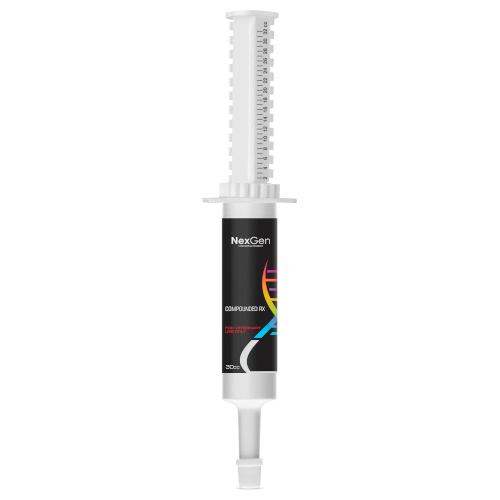
Omeprazole 228 mg/mL + Misoprostol 0.14 mg/mL, Oral Paste, 30mL Syringe
Login for pricing
- Brand
- Mixlab
- SKU:
- NC-0096
- Product Type:
- Paste
- Size:
- 30ml
- Administration:
- Oral
In one study, researchers used six horses treated with either 1 mg/kg or 4 mg/kg of omeprazole while receiving either a high-grain/low-fiber diet or a diet comprised of free-choice hay. The “area under the curve” (AUC), which is a measure of how much of the body is exposed to the drug after administration, was higher in horses treated with 4 mg/kg rather than 1 mg/kg of omeprazole. Although the AUC was higher in horses treated with omeprazole and fed a high-grain/low-fiber diet rather than hay, the difference between the two groups was not statistically significant. Further, there was a great deal of variability observed in the AUCs in the high-grain/low-fiber diet, suggesting that perhaps even though absorption of omeprazole in horses fed hay is lower than the high-grain/low-fiber diet, the absorption is more predictable and therefore desirable.2
Oral paste products containing omeprazole are labeled for use in horses and foals 4 weeks of age and older. The drug effectively treats3,4 and prevents5,6 gastric ulcers, and is considered the drug of choice of equine gastric ulcer syndrome.7 Ulcer healing and improvement was much better when omeprazole was used for squamous gastric ulcers than glandular gastric ulcers.8,9
There is some evidence of efficacy for misoprostol as an allergy medication in dogs, but due to the modest benefits, relatively high costs and adverse effects associated with these medications, they probably should not be used as first line medications to treat dogs with atopic dermatitis.12
Where to buy Omeprazole+Misoprostol:
Omeprazole+Misoprostol is available in the U.S. through veterinary custom compounding companies.
Omeprazole 228 mg/ml / Misoprostol 0.14 mg/ml paste by NexGen is a superior solution for treating and preventing gastroduodenal ulcer disease in horses.
FOR RX ONLY: A valid prescription from a licensed veterinarian is required for dispensing this medication.
2EquiNews.
3Bush J, van den Boom R, Franklin S. Comparison of aloe vera and omeprazole in the treatment of equine gastric ulcer syndrome. Equine Veterinary Journal. 2018;50(1):34-40.
4Kerbyson NC, Knottenbelt DK, Carslake HB, Conwell RC, Sutton DGM, Parkin TDH. A Comparison Between Omeprazole and a Dietary Supplement for the Management of Squamous Gastric Ulceration in Horses. Journal of Equine Veterinary Science. 2016;40:94-101.
5Mason LV, Moroney JR, Mason RJ. Prophylactic therapy with omeprazole for prevention of equine gastric ulcer syndrome (EGUS) in horses in active training: A meta-analysis. Equine Veterinary Journal. 2019;51(1):11-19.
6Endo Y, Tsuchiya T, Sato F, et al. Efficacy of omeprazole paste in the prevention of gastric ulcers in 2 years old thoroughbreds. J Vet Med Sci. 2012;74(8):1079-1081.
7Sykes BW, Hewetson M, Hepburn RJ, Luthersson N, Tamzali Y. European College of Equine Internal Medicine Consensus Statement-Equine Gastric Ulcer Syndrome in Adult Horses. J Vet Intern Med. 2015;29(5):1288-1299.
8Sykes BW, Sykes KM, Hallowell GD. A comparison of three doses of omeprazole in the treatment of gastric ulceration in throughbred racehorses. J Vet Intern Med. 2013;27(3):652-652.
9Sykes BW, Sykes K, Hallowell GD. Comparison of the effect of two doses of omeprazole on the squamous gastric mucosa in thoroughbred racehorses. Vet Rec. 2014;175(10).
10Lupi MP, Passini S, Montoya L, Albarellos G. Influence of the administration of omeprazole on the oral absorption of cephalexin: differences between adults and aged dogs. J Vet Pharmacol Ther. 2015;38:100-100.
11Thames BE, Lovvorn J, Papich MG, et al. The effects of clopidogrel and omeprazole on platelet function in normal dogs. J Vet Pharmacol Ther. 2017;40(2):130-139.
12Olivry T, et al. Treatment of canine atopic dermatitis: 2010 clinical practice guidelines from the International Task Force on Canine Atopic Dermatitis. Veterinary Dermatology. 2010;21(3):233-248.








